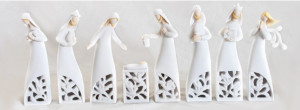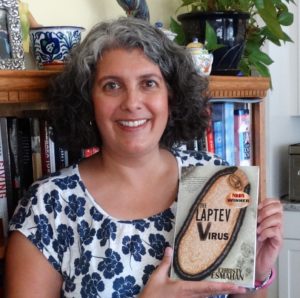
Another beautiful nativity arrangement featured on the Decofilia.com website, used with their permission.
(Several quick notes before you begin reading this blog post: unless you are from Spain and already know what I’m talking about, this post is best read with access to the internet—and perhaps headphones—so you can listen to the songs as I discuss them. Also, for most of them, you might want to minimize the screen or shut off the image as most of the videos are very lame. Finally, the recordings are of the full length song, but usually after listening for about a minute, possibly less, you’ll get the gist of what I’m trying to say, at which point, unless you have lots of spare time or just adore that music, feel free to click off the site and continue reading.)
I grew up adoring Christmas carols—I like them so much, as a matter of fact, that even though my son was born in July, I sang him carols pretty much non-stop as I held him through the summer. But, my first year in Spain, by the time Christmas rolled around, I was feeling a bit homesick and ready to hear the familiar “jingle-bells,” “silent night,” and “sleigh ride” songs. I had learned many of these in Spanish, along with “Feliz Navidad—I wanna wish you a merry Christmas” in high school Spanish classes, and I figured I was prepared. So imagine my astonishment when I heard this one about bells, appropriately named “Campana sobre campana” but not sounding a bit like sleigh bells, silver bells, or any other bell song I’d ever heard: Besides being a completely different melody, I was surprised to learn that, like the majority of the Spanish carols, it was sung by groups of children. In the US, other than the chipmunk song, the vast majority of carols you hear on the radio are sung by adults.
Although many of the villancicos, as Spanish carols are called, end up speaking of the birth, or refer to the Belen, some of them do it in a very roundabout way. This one, for example, is called “Los peces en el rio” which means, the fish in the river, and the chorus is all about the way the fish in the river are “drinking and drinking and drinking some more” as they contemplate the birth. It also talks of the Virgin Mary combing her hair, made of gold, with a comb made of silver. It’s a catchy tune, and one of my favorites, though I had a hard time finding a version that I liked for today’s blog. I settled on this one, even though the pace is a little slow, but you’ll see what I mean: In any case, once again, both the melody and the words are completely different from carols we have in English.
The word, “villancicos”, it turns out, has its roots in “villas”—villages. According to Wikipedia, villancicos were originally non-religious songs, popular tunes, which the church decided to bring into its Christmas liturgy beginning in the 15th century. My guess is that villagers would have resisted having the church completely alter some of their favorite songs, like the one about the fishes in the river, so large swaths were left intact and then some Christmas lines were added.
Some of my favorite villancicos have words that are tongue twisters and to this day, I have trouble singing them as quickly as the song demands. For instance, the one called Una Burra Rin-Rin has a slow part and very fast part–great practice for conjugating verbs. Another fun one is called, “Ay del chiquirritin” It’s really great if you need practice rolling your “r’s”. And then there’s another beautiful one called “A la nanita nana” which is sung by Sofia Rimoldi in this clip. This was one of the few videos I found sung by an adult, and she does a lovely job. I don’t think she’s a famous artist—just someone who made a video of herself. Doesn’t she have a wonderful voice? This is one of the few versions that I enjoyed listening to the whole way through, and watching her sing and play the guitar. I can really hear the Arabic roots in this melody as well. And, no surprise, it’s more of a lullaby than a carol.
One of the songs which seems to definitely have a tropical slant to it, and may have been imported from Latin America is one about a donkey, called “Mi burrito sabanero” Do you agree? And are you beginning to pick up on the pattern of having some lines sung by one person, while the chorus is sung by a group? According to Wikipedia,this is typical of the folk songs that were popular during the renaissance period in Spain and Portugal. So I could be completely wrong about the tropical roots of this song.
And there are more favorites, which I loved to use as I taught Spanish. Ones like “Fum, fum, fum” which repeat the date, and say fun nonsense words in middle, pronounced foom, foom, foom, surrounded by short rhyming verses. Or this one with a really fun, upbeat rhythm and lots of repeating choruses. “Ande, ande, ande la Marimorena”
Another of my favorites is “Dime niño de quien eres”, Tell me child, whose son are you? I found another rare clip with an adult singing it, and thus preferred this video by singer Rosa Lopez, who has a very nice voice. You’ll also see that the dancers in the background are doing an adaptation of the traditional flamenco dance, dressed in red and white holiday fare.
And there are so many more, all with music completely unlike any of the carols you can find playing on your radio stations here, (even the ones playing non-stop Christmas songs between Thanksgiving and Christmas!) I’ll leave you with just a few more. “Ya vienen los Reyes Magos” is about the three kings coming, Tutaina is about the shepherds coming to see the baby, and is interesting because the entire chorus is nonsense. “Tutaina tuturuma, tutaina, tuturrumaina, tutaina, tuturruma turruma, tutaina, tuturrumaina.” Makes me wonder if it’s ancient words from a forgotten language. El niño Dios ha nacido is sung by a school choir in Madrid.
The last link, is a composite of about 6 carols in a row. I hope you’ve enjoyed listening to this blog post, and if you’re polishing your Spanish, I recommend you try learning some villancicos—music helps both in pronunciation and rhythm of another language. You can find the words to any of these songs by Googling their title as I’ve written them, followed by the word “letras.”
If you enjoyed this blog about Spain, you might also like my series of novels, Bueno, Sinco and Brujas, which takes place in Santander, Spain.



6 comments
Skip to comment form
I just read your blog; and, off course I had to listen to all the songs. Merry Xmas. Thank you for sharing
Author
I’m glad you enjoyed it, Hannah! Happy Holidays!
Great post, Christy! Really enjoyed it!
Author
Thank you, Robbie! 🙂
Author
Thanks, Jyothi! And, yes, it’s a hauntingly beautiful song–I’ve got it stuck in my mind now. 🙂
A la Nanita Nana was my favorite. Good blog perfect timing.